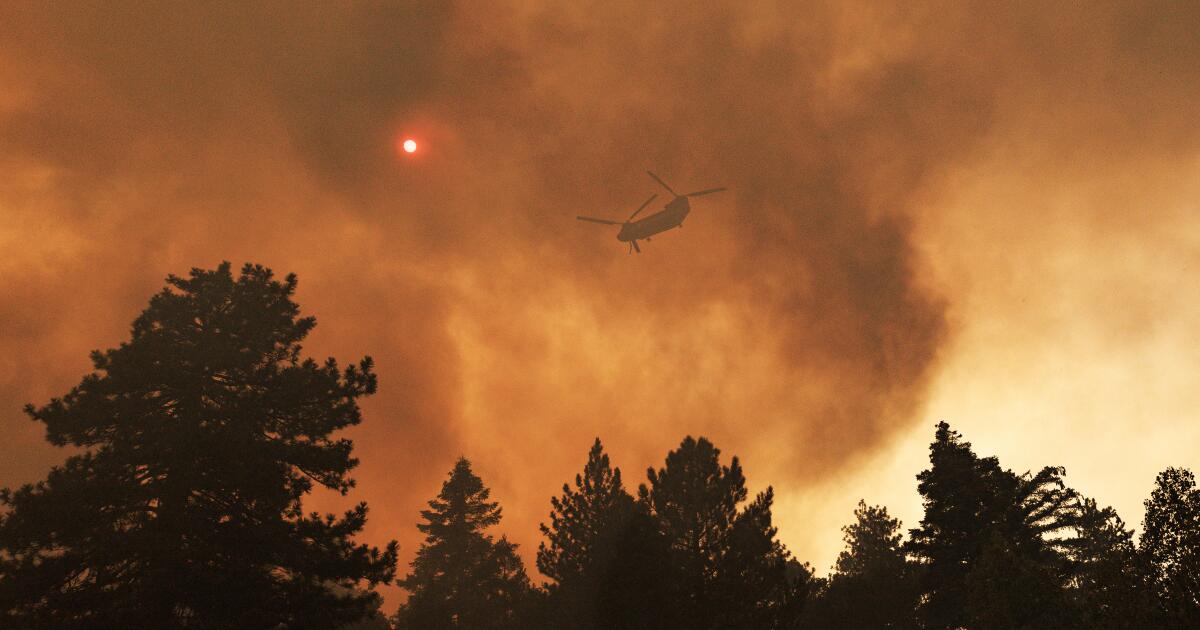Plumes of smoke from Southern California’s fires blew across Big Bear on Sept. 11, causing local air quality meters to return off-the-chart readings for particulate pollution.
Officials report air quality on a color-coded scale, in which green indicates “good” and maroon denotes “hazardous” conditions. An air quality index above 150 is considered unhealthy for everyone. Above 300 is considered hazardous.
On Wednesday, Big Bear’s AQI for fine particulate matter, or PM2.5, reached a breathtaking daily average of 593.
The reading was the third-highest AQI measured in Southern California since at least 1999, according to data from the U.S. Environmental Protection Agency.
The first- and second-worst air quality days were recorded in Ventura County during the 2017 Thomas fire, the state’s largest wildfire on record. On Dec. 6 and 8, the Ojai monitoring station recorded daily average AQIs of 961 and 906, respectively.
Weeks of sweltering heat primed Southern California’s hills and mountains to burn.
Between Sept. 5 and 9, three wildfires erupted: The Line fire in San Bernardino County, the Bridge fires in San Bernardino and Los Angeles counties and the Airport fire in Orange County.
The Line fire began on Sept. 5 in Highland and soon spread through the mountains toward Big Bear. A 34-year-old Norco man has been arrested on suspicion of igniting the blaze.
As of Friday, more than 38,000 acres of the San Bernardino Mountains had been consumed by the flames. While the fire hasn’t reached the resort areas, the ash particles and haze enveloped the skies of the mountain communities.
High winds carried plumes of smoke throughout Big Bear Valley, closing ski resorts and most local businesses. Much of the area is still under an evacuation warning, with parts of the town ordered to leave.
“I think every agency is doing everything in their power to control this fire so many communities don’t get destroyed,” said Big Bear Lake City Manager Erik Sund.
Particulate pollution, including from wildfire smoke, is dangerous to almost everyone: pregnant women, young children, older people and adults with underlying conditions.
Fine particulate matter can be the more damaging to people’s health than other pollutants, such as ozone. The tiny particles, roughly one-thirtieth the width of a human hair, can easily penetrate the lining of the lungs and infiltrate the blood stream. A 2023 study linked long-term PM2.5 exposure to an increased risk of dementia.
“I worry about the differential impact of wildfire smoke. Even if the affluent get exposed to the same smoke as low-income communities, the low-income communities have less ability to protect themselves,” said Dr. John Balmes, a professor of medicine at UC San Francisco and a member of the California Air Resources Board. “Where the plume of smoke is going is where the biggest effect will be.”
In August, Balmes and Jason G. Su, an environmental health sciences researcher at the UC Berkeley School of Public Health, published a paper that found communities of color are exposed to higher levels of air pollution than other communities.
During wildfire season, experts recommend Californians keep tabs on local air quality monitoring reports, available from the U.S. EPA’s AirNow.gov or services such as PurpleAir.
“If the least you can do is stay inside and close all your windows and doors, that will substantially reduce your exposure,” said Suzanne Paulson, a professor of atmospheric and oceanic sciences at UCLA. “If you’re trying to exercise, try to get out of that dark orange, red and that sort of horrifying dark purple-brown color that’s used for the really high AQIs.”
